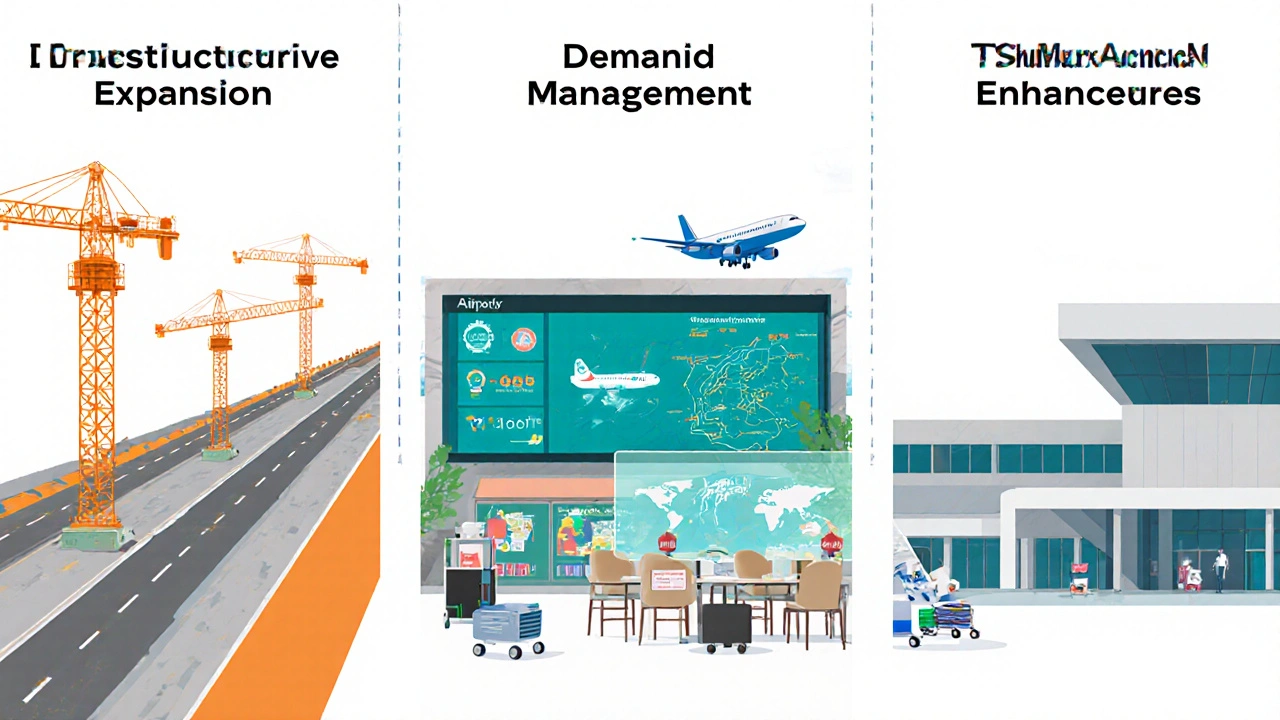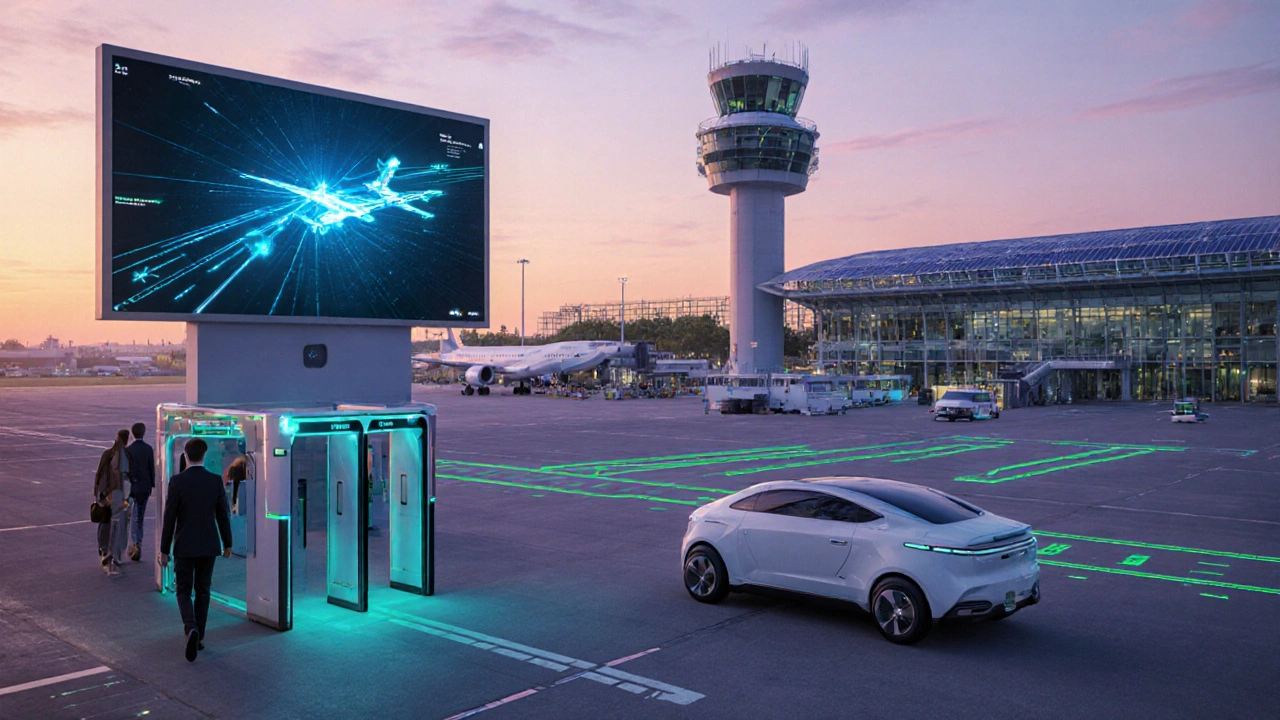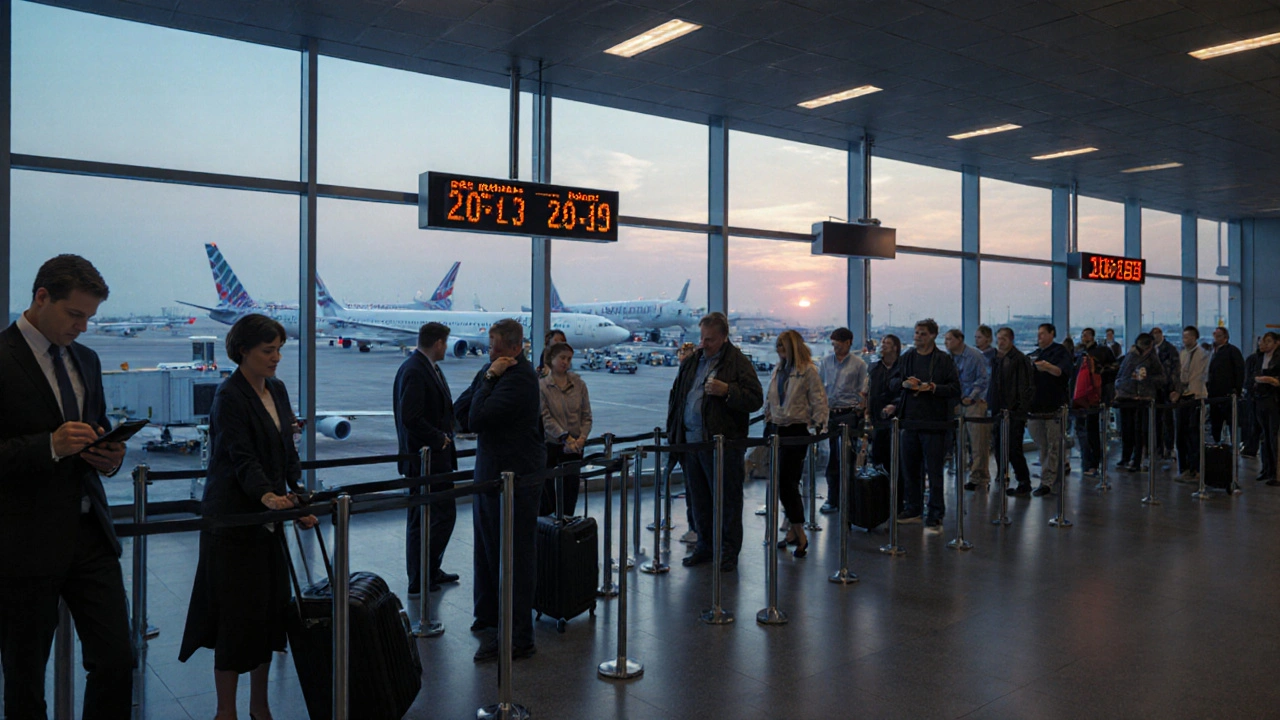Airport Congestion Impact Calculator
Total Daily Economic Loss: $0
Total Missed Connections: 0
Average Delay per Passenger: 0 minutes
Total Passenger Frustration Index: 0
Solutions Overview
Infrastructure
Add runways, terminals, or taxiways to increase capacity.
Cost: HighDemand Management
Use pricing and incentives to spread traffic.
Cost: LowTechnology
Deploy AI, automation, and GPS systems.
Cost: ModeratePolicy
Enforce regulations for efficient operations.
Cost: VariableEvery time you stand in line for security or watch planes taxi forever, you’re feeling the strain of airport congestion. It’s not just an annoyance - it hits airlines’ bottom lines, hurts local economies, and can even affect safety. Below we break down why airports get jammed, what’s at stake, and real‑world ways to untangle the mess.
Key Takeaways
- Congestion stems from limited runway capacity, slot allocation bottlenecks, and uneven passenger flow.
- Air traffic control, baggage handling, and ground transportation all amplify the problem.
- Solutions fall into three buckets: expand infrastructure, manage demand, and boost technology.
- Integrated strategies that blend short‑term tweaks with long‑term investments deliver the best results.
- Future tools like AI‑driven predictive scheduling promise to keep queues short and runways moving.
Understanding Airport Congestion
Airport congestion is a condition where the demand for airport services exceeds the facility’s ability to process aircraft and passengers efficiently. It shows up as long taxi times, delayed take‑offs, crowded terminals, and missed connections. While a single delayed flight can be a hiccup, chronic congestion creates ripple effects across the entire aviation ecosystem.
Core Challenges Behind the Bottlenecks
Runway capacity is the most visible limit. Most airports have one or two runways, each with a maximum number of movements per hour. When airlines schedule beyond that ceiling, air traffic control (ATC) teams scramble to sequence take‑offs and landings, often resorting to holding patterns that waste fuel and increase emissions.
Another hidden choke point is slot allocation. Slots are the timed windows that dictate when an airline can land or depart. In busy hubs, the slot market becomes fiercely competitive, and when slots are over‑booked, airlines push flights into adjacent slots, creating a cascading delay effect.
Passenger flow inside terminals adds a layer of complexity. Passenger flow models often underestimate peak hour surges, leading to long security lines, crowded boarding gates, and strained baggage claim areas. The latter is tied to baggage handling systems that struggle to keep up, causing missed luggage and further passenger dissatisfaction.
External factors like weather, runway maintenance, and even nearby construction can temporarily reduce capacity, but without built‑in buffers, even minor disruptions snowball into major delays.

Impact on Stakeholders
Airlines lose revenue through missed connections, crew overtime, and the cost of compensations. Passengers face missed meetings, extra hotel nights, and stress-averaging $200 in indirect costs per delayed trip, according to a 2024 airline industry study.
Airports themselves see lower slot utilization rates and reduced retail spend. A 2023 report showed that for each 5‑minute increase in average delay, ancillary revenue drops by about 1.2%.
Local economies feel the pinch too. Airports are often the largest employers in a region; when congestion hampers flight frequency, tourism numbers dip, directly affecting hotels, restaurants, and transportation services.
Solution Approaches
Experts recommend tackling congestion from three angles: expanding physical capacity, managing demand, and leveraging technology.
1. Infrastructure Expansion
Adding runways, widening taxiways, or building parallel terminals directly raises the ceiling for movements per hour. For instance, Denver International added a parallel runway in 2021, boosting its capacity by 15% and reducing average taxi time from 12 to 7 minutes.
However, expansion projects are capital‑intensive (often $1‑2billion per runway) and face environmental reviews that can stretch timelines to a decade.
2. Demand Management
Instead of building more, airports can smooth out peaks. Strategies include:
- Dynamic slot pricing that makes peak‑hour slots more expensive, encouraging airlines to shift flights.
- Incentives for off‑peak travel, such as reduced terminal fees for early‑morning departures.
- Collaborative decision‑making (CDM) platforms where airlines, ATC, and ground handlers share real‑time data to adjust schedules on the fly.
These measures are quicker to implement and often yield a 5‑10% reduction in average delay within the first year.
3. Technology Enhancements
Modern software can orchestrate airport operations like a symphony. Key technologies include:
- Advanced surface movement guidance and control systems (A‑SMGCS) that guide aircraft on the ground using GPS‑based overlays, cutting taxi times by up to 30%.
- AI‑driven predictive analytics that forecast weather‑related disruptions and suggest pre‑emptive slot reshuffles.
- Automated baggage handling with RFID tagging, which reduces mishandling rates from 5% to under 1%.
- Biometric security checkpoints that speed up passenger throughput while maintaining safety.
Comparison of Major Solution Types
| Solution | Description | Pros | Cons | Typical Timeline |
|---|---|---|---|---|
| Infrastructure Expansion | New runways, terminals, or taxiways. | Direct capacity boost; long‑term ROI. | High capital cost; regulatory delays. | 5‑10 years |
| Demand Management | Dynamic slot pricing, off‑peak incentives. | Low cost; quick to deploy. | Requires airline cooperation; may shift congestion. | 6‑12 months |
| Technology Enhancements | A‑SMGCS, AI scheduling, automated baggage. | Improves efficiency without physical expansion. | Initial integration complexity; staff training. | 12‑24 months |
| Policy & Regulation | Mandated curfews, emissions caps, slot reforms. | Can force systemic change. | Potential pushback from carriers. | Variable |

Implementing an Integrated Strategy
- Conduct a data‑driven capacity audit. Use ATC logs, passenger counts, and baggage throughput metrics to pinpoint the exact bottlenecks.
- Prioritize quick‑win technology upgrades-install A‑SMGCS on high‑traffic taxiways and roll out biometric checkpoints at the busiest security lanes.
- Launch a pilot demand‑management program with a handful of airlines, testing dynamic slot pricing during peak hours.
- Develop a long‑term master plan for runway or terminal expansion, incorporating environmental impact studies early to avoid delays.
- Establish a collaborative decision‑making hub where ATC, airlines, ground handlers, and airport operators share real‑time data via a cloud‑based platform.
By layering these steps, airports can see immediate relief while positioning themselves for sustained growth.
Future Outlook
Looking ahead to 2030, several emerging trends promise to reshape congestion dynamics. AI‑powered predictive models will simulate hundreds of scenarios before a single flight takes off, allowing airports to pre‑emptively re‑schedule. Remote towers-where ATC services are provided from a central hub via high‑definition video-could free up local airspace, effectively increasing runway capacity without new construction.
Moreover, electric ground support equipment reduces emissions and speeds up turnaround times, indirectly easing runway usage.
All these innovations hinge on strong data governance and cross‑industry cooperation, but the upside-a smoother, greener travel experience-is worth the effort.
Frequently Asked Questions
What causes runway capacity to be limited?
Runway capacity depends on runway length, number of intersecting taxiways, weather‑related visibility restrictions, and the spacing required between aircraft for safe take‑offs and landings. Shorter runways or those with many crossings often handle fewer movements per hour.
How does slot allocation affect congestion?
Slots assign specific times for arrivals and departures. When too many airlines request the same slot windows, ATC must sequence aircraft tightly, leading to holding patterns and longer taxi times. Proper slot management spreads traffic more evenly across the day.
Can technology alone solve airport congestion?
Technology can dramatically improve efficiency-AI scheduling, advanced surface guidance, and automated baggage handling cut delays by up to 30%. However, without sufficient physical capacity or demand‑management policies, tech fixes hit diminishing returns.
What is collaborative decision‑making (CDM)?
CDM is a process where airlines, ATC, ground handlers, and the airport share real‑time operational data to make coordinated decisions. It helps re‑allocate slots, adjust gate assignments, and reduce cascade delays.
Are remote air traffic towers reliable?
Early deployments in Sweden and Canada have shown that high‑definition video and low‑latency links can match traditional towers in safety metrics. They also free up local airspace, effectively increasing runway throughput.







Zachary Endres
October 5, 2025 AT 17:26Wow, the idea of tackling airport congestion with a mix of infrastructure upgrades and smart demand management feels like a breath of fresh air!
Imagine the day when we can glide through security without the dreaded endless lines, thanks to AI‑driven scheduling.
Investing in new runways may look pricey, but the long‑term payoff for travelers and airlines alike is huge.
Even low‑cost solutions like dynamic pricing can spread the traffic and keep the skies moving.
Let’s keep pushing these innovative ideas forward, because the future of air travel deserves nothing less.
Ashley Stauber
October 5, 2025 AT 23:33The whole runway expansion plan is just a massive waste of taxpayer money.
Amy Elder
October 6, 2025 AT 07:53Adding more runways could really cut down wait times and make flights smoother.
Tech like AI can route planes more efficiently too.
Even simple pricing tweaks can help spread peak demand.
All these steps together could make traveling less stressful.
Hope airports start adopting them soon.
Erin Devlin
October 6, 2025 AT 16:13Congestion is a symptom of demand outpacing capacity; balancing the two is essential for sustainable growth.
Thus, policy and technology must walk hand in hand.
Raghav Narayan
October 7, 2025 AT 01:56The persistent issue of airport congestion manifests itself not only in passenger frustration but also in measurable economic detriments to the aviation sector.
Empirical studies indicate that each minute of delay can translate into thousands of dollars in ancillary costs, ranging from fuel inefficiencies to missed connections.
Consequently, a multidimensional approach that integrates infrastructural expansion, demand management, advanced technological deployment, and regulatory reforms is warranted.
From an infrastructural perspective, the addition of parallel runways and auxiliary taxiways can substantially increase throughput capacity, albeit with considerable capital investment.
Demand management strategies, such as variable slot pricing and incentivized off‑peak travel, have demonstrated efficacy in flattening peak load curves without necessitating extensive construction.
Technological interventions, including the implementation of satellite‑based navigation, machine‑learning driven scheduling algorithms, and automated baggage handling systems, can optimize existing resources and reduce bottlenecks.
Regulatory policies that enforce stricter turn‑around time standards and streamline air traffic control procedures further complement these measures.
Moreover, collaborative decision‑making frameworks that engage airlines, airport authorities, and ground service providers foster a culture of shared responsibility.
Financial analysis suggests that the return on investment for technology‑focused solutions often surpasses that of traditional physical expansions, particularly in dense urban corridors.
Nonetheless, the feasibility of large‑scale runway projects is frequently constrained by land availability, environmental considerations, and community opposition.
In such contexts, a phased implementation plan that prioritizes low‑cost, high‑impact initiatives can deliver immediate relief while longer‑term projects are pursued.
Stakeholder communication is pivotal; transparent reporting of congestion metrics and projected benefits can mitigate public resistance.
Benchmarking against leading global hubs reveals that airports which have successfully reduced delay times employ a balanced blend of the aforementioned strategies.
Therefore, policymakers should allocate resources judiciously, emphasizing solutions that yield swift operational improvements and sustainable growth.
In summary, addressing airport congestion demands an integrated roadmap that harmonizes infrastructure, economics, technology, and governance to secure the future efficiency of air travel.
Tara Phillips
October 7, 2025 AT 08:53Implementing strategic demand‑management incentives will undeniably accelerate the transition toward smoother airport operations, and we must champion these initiatives with unwavering resolve.
Derrick Blount
October 7, 2025 AT 17:13While the article correctly outlines infrastructure, demand‑management, technology, and policy as core pillars, it neglects to mention, for instance, the critical role of real‑time data analytics, which can-when integrated-optimize gate assignments, reduce taxi‑out times, and consequently diminish overall delays.
Anna Graf
October 8, 2025 AT 01:33Airports are like busy kitchens; you need the right tools and timing, otherwise the soup gets cold.
Jarrod Benson
October 8, 2025 AT 11:16Man, I've been stuck in those endless security lines for hours, and it feels like the airport just forgot about our time.
What really blows my mind is that a simple tweak in the flight schedule could shave off that wasted time.
I read that some hubs use AI to predict passenger flow and open extra security lanes on the fly.
If we could get more of those smart systems rolling out, we'd all be thanking the tech guys.
Also, think about dynamic pricing-charging a bit more for peak slots could push some travelers to off‑peak flights.
That would spread out the crowd and make the whole experience less chaotic.
Sure, building a new runway costs a fortune, but combining tech and smart pricing might be the sweet spot.
Bottom line: we need a mix of gadgets and incentives to keep the skies moving smoothly.
Liz .
October 8, 2025 AT 18:13love the idea of using AI to cut down wait times it could really change the game for travelers
tom tatomi
October 9, 2025 AT 02:33Even with data analytics, the human factor still creates unpredictable bottlenecks.
Tom Haymes
October 9, 2025 AT 10:53Indeed, the holistic roadmap you outlined resonates with the ancient principle that balance between structure and flow yields harmony; airports, like any complex system, thrive when every element aligns toward shared efficiency.
Scott Kohler
October 9, 2025 AT 19:13Ah, the classic “just build more runways” mantra-because pouring billions into concrete always solves nuanced operational challenges, right?
Brittany McGuigan
October 10, 2025 AT 03:33We must not overlook the imporant role of community support; engagin locals early can preve nt opposition and streamline expansion projects.
Priya Vadivel
October 10, 2025 AT 11:53Indeed, community engagement is a cornerstone of sustainable airport development; however, it is imperative to articulate clear communication channels, establish transparent feedback mechanisms, and ensure that all stakeholders-ranging from local residents to airline partners-feel duly represented in the decision‑making process.
Dharmraj Kevat
October 10, 2025 AT 20:13Runways rise like steel giants, passengers' patience thins, and the sky waits.